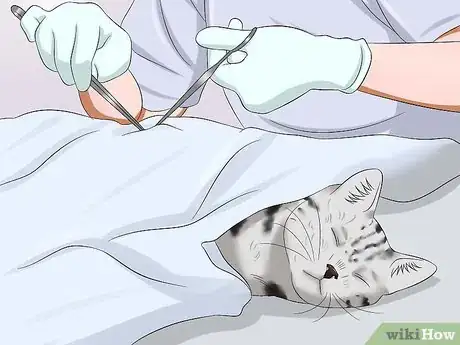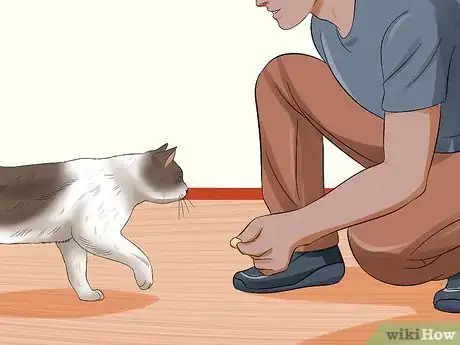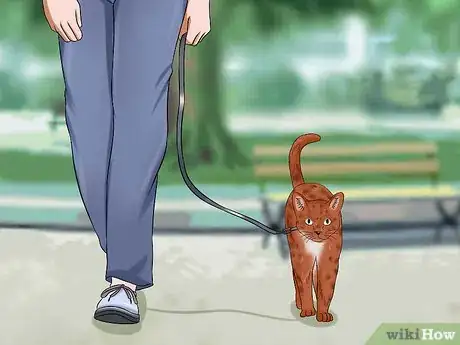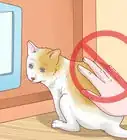This article was co-authored by Francine Miller. Francine Miller is an Applied Animal Behavior Counselor and Founder of Call Ms Behaving, a behavior counseling service for dogs and cats in San Diego, California. With over 16 years of experience, Francine specializes in treating behavior problems such as aggression, separation anxiety, phobias, fear reactions, destructiveness, urine marking, and compulsive behaviors. She uses a behavioral management and modification plan that is positive reinforcement only. She holds a Diploma in Canine Behavior Counseling from the American College of Applied Science (ACAS). Francine has completed all coursework toward an MS in Applied Animal Behavior Science and Family Counseling for Companion Animals from the American College of Applied Science (ACAS). She is a certified Associate of the International Association of Animal Behavior Consultants (IAABC) and a member of the Pet Professional Guild.
wikiHow marks an article as reader-approved once it receives enough positive feedback. In this case, several readers have written to tell us that this article was helpful to them, earning it our reader-approved status.
This article has been viewed 193,920 times.
We do all we can to keep our cats health and happy. But even when we've created the perfect world for our cats at home, the call of nature still beckons. Cats may want to run outside for a variety of reasons, but to keep them safe, it's important to find ways of making sure they don't go out without their human. Making your cat happy and providing some incentives to stay indoors will prevent your kitty from running out the door.
Steps
Discouraging Cat from Running Away
-
1Use an alternate entrance and exit. If your cat is constantly hanging out by the front door, waiting to make its escape when some unwitting person opens it, try exiting out a different door. For instance, instead of going in and out through the front door, try using the back or garage door. Another good option is to exit and enter via a door with an antechamber. After passing through the first door, close it firmly behind you and look about to ensure your feline friend hasn’t followed you. If your cat does get past the first door, you’ll notice and be able to put him or her back inside before exiting the secondary door which actually leads outside.
- When you have guests over, put your cat in another room until the festivities are over. This way, when people come through the main door, your cat won’t be around to dart through it.
-
2Don’t give your cat any attention at the door.[1] If your cat thinks that being near the door is a place where you will pet or play with it, your cat will gravitate toward the door. If your cat is in the habit of greeting you and getting a friendly hello right when you walk in, break yourself of that habit.
- Don’t even look at your cat until after you’ve taken your shoes off, removed your jacket, and moved away from the door. Instead, greet your cat warmly and pat it’s head only in the living room, bedroom, or hallway. This way, the cat will learn to meet you at the place where it knows you’ll give it attention.
- Do the same thing when you leave. Instead of bidding your cat farewell at the door, do so at your designated hello/goodbye spot.
Advertisement -
3Lock your cat door.[2] If your cat is going in and out as it pleases because you have a cat door, utilize a lock or a sliding latch to prevent it from darting outside. If you do not have a cat door with a lock or sliding latch, you can easily attach one and open it during certain times of the day when you want to allow your cat to go outside.
-
4Teach your cat to sit. Teach your cat to station—or sit in a specific place—somewhere away from the door. Use a clicker and train the cat just like you would train a dog. Teaching station cues and sit cues are easy and fun.[3]
-
5Spay or neuter your pet.[4] If your cat is not spayed or neutered, it will have the urge to wander about looking for potential mates more than a cat who is. If your cat is fixed, on the other hand, it will have no desire to breed and thus be more inclined to stay home.
- It’s typically safe for cats as young as eight weeks old to be spayed or neutered, but you should always ask your vet if and when it is possible for your cat to be sterilized.[5]
Making Kitty Happy So It Doesn’t Run Away
-
1Distract your cat from the door. When you leave the house for a long period, give your cat a treat. If your cat busies itself with nibbling its treat instead of darting out the door, your problem is solved. You could also give your cat a puzzle feeder on your way out in order to distract it from the fact that you’re leaving.[6] A puzzle feeder is a small device -- often a rubber ball or oblong shape -- with a small hole and hollow middle into which bits of kibble or cat treats are placed. The puzzle feeder gives the cat stimulation -- potentially for hours -- as well as a yummy snack. The puzzle feeder will keep it from running outside.
-
2Provide entertainment.[7] There are many forms of entertainment available for cats, though not all will actually capture your particular kitty’s attention. Experiment with a variety of entertainment options and see which keep your pet engaged.
- For instance, bring a few plants inside. These will provide interesting smells for your cat. Avoid plants like amaryllis, chrysanthemums, irises, lilies, and tulips, which can be toxic to cats.[8]
- Hide some treats throughout the house. You can hide them in puzzle feeders or just easily accessible in unusual locations.[9]
- Offer your cat a variety of toys like rolling balls, scratching posts, and a few wadded-up balls of paper.[10]
- Your cat might also enjoy watching TV. If you have Animal Planet, NatGeo, or other nature programming, these are best. DVDs made specifically to entertain cats are also available, featuring footage of other animals.
-
3Let your cat explore the great outdoors. Create a kitty enclosure or walk your cat regularly.[11] Your cat runs outside because he or she wants to get out and explore. They want fresh air, sunshine, and new, exciting smells! Fortunately, you can reduce your cat’s desperate jailbreak attempts by letting your cat experience a bit of the great outdoors.
- If you have a screened porch, give your cat access to it. Ensure there are plenty of perches in it so that your kitty can see outside.
- If you don’t have a screened porch, you can easily obtain some plastic or wire fencing and make a small enclosure which allows your cat to spend time outside without running out the front door. Provide access to the enclosure via a back door or open window. If your enclosure’s walls are at least seven feet high, you do not need to include a roof.
Expert Q&A
Did you know you can get expert answers for this article?
Unlock expert answers by supporting wikiHow
-
QuestionHow do I stop my cat from running out the door?
 Francine MillerFrancine Miller is an Applied Animal Behavior Counselor and Founder of Call Ms Behaving, a behavior counseling service for dogs and cats in San Diego, California. With over 16 years of experience, Francine specializes in treating behavior problems such as aggression, separation anxiety, phobias, fear reactions, destructiveness, urine marking, and compulsive behaviors. She uses a behavioral management and modification plan that is positive reinforcement only. She holds a Diploma in Canine Behavior Counseling from the American College of Applied Science (ACAS). Francine has completed all coursework toward an MS in Applied Animal Behavior Science and Family Counseling for Companion Animals from the American College of Applied Science (ACAS). She is a certified Associate of the International Association of Animal Behavior Consultants (IAABC) and a member of the Pet Professional Guild.
Francine MillerFrancine Miller is an Applied Animal Behavior Counselor and Founder of Call Ms Behaving, a behavior counseling service for dogs and cats in San Diego, California. With over 16 years of experience, Francine specializes in treating behavior problems such as aggression, separation anxiety, phobias, fear reactions, destructiveness, urine marking, and compulsive behaviors. She uses a behavioral management and modification plan that is positive reinforcement only. She holds a Diploma in Canine Behavior Counseling from the American College of Applied Science (ACAS). Francine has completed all coursework toward an MS in Applied Animal Behavior Science and Family Counseling for Companion Animals from the American College of Applied Science (ACAS). She is a certified Associate of the International Association of Animal Behavior Consultants (IAABC) and a member of the Pet Professional Guild.
Certified Animal Behavior Counselor
-
QuestionHow do you keep a cat from rushing outside?
 Francine MillerFrancine Miller is an Applied Animal Behavior Counselor and Founder of Call Ms Behaving, a behavior counseling service for dogs and cats in San Diego, California. With over 16 years of experience, Francine specializes in treating behavior problems such as aggression, separation anxiety, phobias, fear reactions, destructiveness, urine marking, and compulsive behaviors. She uses a behavioral management and modification plan that is positive reinforcement only. She holds a Diploma in Canine Behavior Counseling from the American College of Applied Science (ACAS). Francine has completed all coursework toward an MS in Applied Animal Behavior Science and Family Counseling for Companion Animals from the American College of Applied Science (ACAS). She is a certified Associate of the International Association of Animal Behavior Consultants (IAABC) and a member of the Pet Professional Guild.
Francine MillerFrancine Miller is an Applied Animal Behavior Counselor and Founder of Call Ms Behaving, a behavior counseling service for dogs and cats in San Diego, California. With over 16 years of experience, Francine specializes in treating behavior problems such as aggression, separation anxiety, phobias, fear reactions, destructiveness, urine marking, and compulsive behaviors. She uses a behavioral management and modification plan that is positive reinforcement only. She holds a Diploma in Canine Behavior Counseling from the American College of Applied Science (ACAS). Francine has completed all coursework toward an MS in Applied Animal Behavior Science and Family Counseling for Companion Animals from the American College of Applied Science (ACAS). She is a certified Associate of the International Association of Animal Behavior Consultants (IAABC) and a member of the Pet Professional Guild.
Certified Animal Behavior Counselor
-
QuestionShould I pick a leash or a harness for my cat? Do cats like them very much?
 Community AnswerSome cats love to walk outside using a harness and leash (you will need both if you want to walk your cat, and you must never try to walk a cat with a collar and leash). Try to find a comfortable looking harness. To make sure your cat gets used to it, let it wear the harness indoors and use treats to make it a positive experience. However, keep in mind that some cats don't like harnesses at all.
Community AnswerSome cats love to walk outside using a harness and leash (you will need both if you want to walk your cat, and you must never try to walk a cat with a collar and leash). Try to find a comfortable looking harness. To make sure your cat gets used to it, let it wear the harness indoors and use treats to make it a positive experience. However, keep in mind that some cats don't like harnesses at all.
Warnings
- Don't try to close the door fast. It makes the cat think its now or never and doing so may result in accidentally harming the cat if it is not fast enough getting out the door.⧼thumbs_response⧽
References
- ↑ http://www.catbehaviorassociates.com/door-darting/
- ↑ http://www.petsafe.net/learn/5-ways-to-keep-your-cat-from-escaping
- ↑ Francine Miller. Certified Animal Behavior Counselor. Expert Interview. 10 September 2020.
- ↑ http://www.petsafe.net/learn/5-ways-to-keep-your-cat-from-escaping
- ↑ http://www.aspca.org/pet-care/general-pet-care/spayneuter-your-pet
- ↑ http://www.catbehaviorassociates.com/door-darting/
- ↑ http://www.catster.com/lifestyle/cat-training-behavior-5-tips-door-dart-escape
- ↑ http://pets.webmd.com/features/keeping-indoor-cat-happy
- ↑ Francine Miller. Certified Animal Behavior Counselor. Expert Interview. 10 September 2020.
About This Article
To keep your cat from running out the door, give your cat a treat before you open the door so it's distracted while you leave. Additionally, avoid greeting your cat when you come through the door, since it will associate the door with getting affection from you. Instead, pat your cat only after you've taken off your shoes and moved away from the door. Alternatively, install a pet-proof spray near the door as it will emit an irritating but harmless spray when your cat approaches the door. For tips on how to create an enclosure so your cat can explore outside, read on!







































































